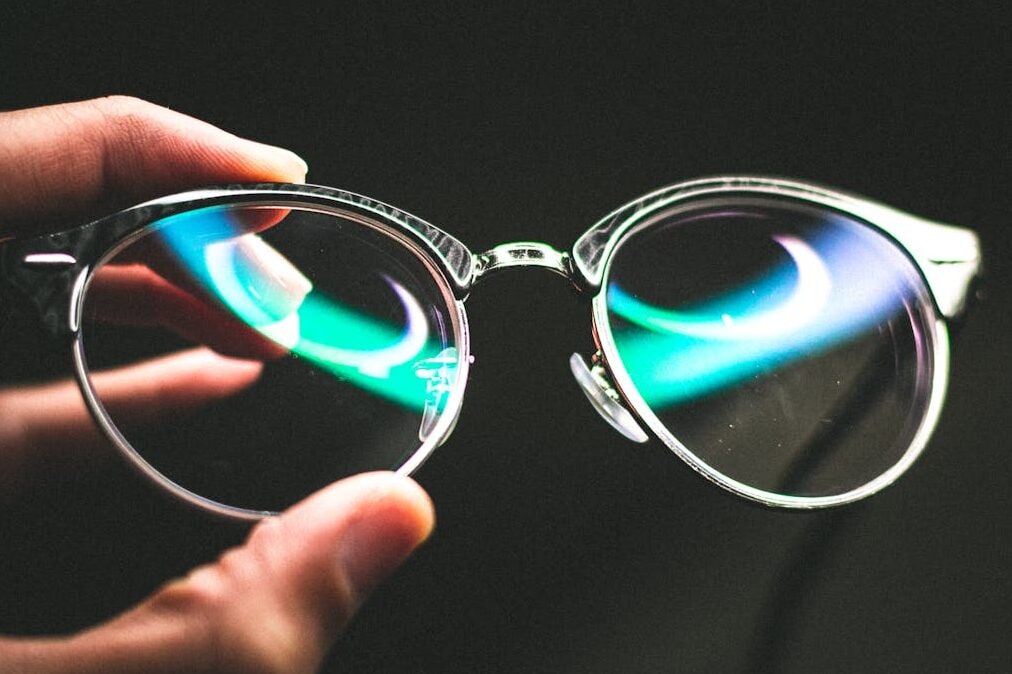
Anti-reflective (AR) coating, also known as anti-glare coating for eyeglasses is a specialized optical coating applied to lenses to reduce reflections and glare, enhancing vision clarity and comfort. Here’s an in-depth look at the science behind AR coatings for eyeglasses:
How Anti-Reflective Coating Works
Principle of Interference
- Destructive Interference:
- AR coatings function based on the principle of destructive interference. When light waves reflect off the surfaces of the lens, they can interfere with each other.
- The coating is designed so that the reflected light waves from the front and back surfaces of the coating layer are out of phase by half a wavelength. This phase difference causes the light waves to cancel each other out, reducing reflections.
Refractive Index
- Optimal Refractive Index:
- The effectiveness of an AR coating depends on the refractive index of the coating material relative to the lens material.
- An ideal AR coating has a refractive index that is the geometric mean of the refractive indices of air (n≈1) and the lens material (n varies, typically around 1.5-1.7 for common lens materials like polycarbonate or high-index plastics).
- For instance, if the lens material has a refractive index of 1.5, the optimal refractive index for the coating would be √1.5 ≈ 1.22.
Multiple Layers
- Broad-Spectrum Reduction:
- Single-layer coatings are effective for a specific wavelength of light. To cover a broader range of wavelengths (i.e., the entire visible spectrum), multiple layers of AR coatings are used.
- Each layer is designed to cancel out reflections at different wavelengths, achieving broad-spectrum anti-reflective properties.
Benefits of Anti-Reflective Coating
- Improved Vision:
- Reduces glare from light sources such as headlights, computer screens, and sunlight.
- Enhances contrast and visual acuity, especially in low-light conditions.
- Aesthetic Benefits:
- Makes lenses appear nearly invisible, improving the wearer’s appearance by eliminating distracting reflections.
- Allows others to see the wearer’s eyes more clearly, which is beneficial for eye contact and communication.
- Reduced Eye Strain:
- Minimizes the amount of light reflecting off the lenses, reducing eye fatigue and discomfort, particularly during prolonged use of digital devices.
- Enhanced Durability:
- Many AR coatings include additional layers that provide scratch resistance and UV protection.
- Some coatings also have hydrophobic (water-repellent) and oleophobic (oil-repellent) properties, making lenses easier to clean.
Manufacturing Process
- Vacuum Deposition:
- The AR coating is applied through a vacuum deposition process, where the coating material is vaporized in a vacuum chamber and then condenses onto the lens surface.
- This method ensures a uniform and precise coating thickness, which is crucial for the interference effects to work correctly.
- Material Selection:
- Common materials for AR coatings include magnesium fluoride (MgF2) for single-layer coatings and various metal oxides (like titanium dioxide (TiO2) and silicon dioxide (SiO2)) for multi-layer coatings.
Recommendations for Eyeglass Frames
- Frame Size and Shape:
- For progressive lenses and AR coatings, it’s advisable to choose frames that are not too shallow vertically. A minimum B measurement (vertical height of the lens) of 36mm or more is recommended to ensure adequate lens space for the progressive design and AR coating performance.
Applications
- Daily Eyewear:
- AR coatings are beneficial for everyday eyeglasses, enhancing vision clarity in various lighting conditions.
- Sunglasses:
- AR coatings on the backside of sunglass lenses reduce reflections from sunlight that can bounce off the back surface into the eyes.
- Specialty Eyewear:
- Used in prescription sports goggles, safety glasses, and other specialized eyewear to improve vision and reduce glare.
Conclusion
Anti-reflective coatings for eyeglasses utilize advanced principles of optics to reduce reflections and enhance visual clarity. By carefully designing and applying these coatings, manufacturers can significantly improve the comfort and effectiveness of eyeglasses. AR coatings not only enhance vision and reduce eye strain but also improve the aesthetic appearance of the lenses, making them an essential feature for modern eyewear.

